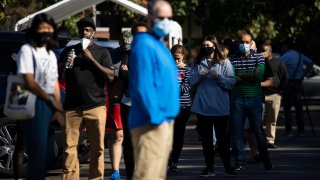
Standing in line comes with its own fear factor in the era of the coronavirus.
Right now, Americans must navigate queues of epic proportions in places that have begun early voting, raising concerns about the possibility of catching COVID-19.
The line at the grocery store is much shorter, but worries can linger there, too. And as cold weather arrives, more lines will be pushed inside, eliminating an important safety measure.
How can you reduce your coronavirus risk in a queue?
TODAY asked Dr. Joseph Khabbaza, a pulmonary and critical care physician at the Cleveland Clinic.
Can you get COVID-19 while standing in line?
Health
Yes, it’s possible if basic guidelines and safety precautions are not followed, Khabbaza said. That would mean a line where people are standing too close — generally less than 6 feet apart — and not wearing masks while spending prolonged periods of time indoors with poor ventilation.
But that’s not happening in most places, so it’s not probable to get COVID-19 while waiting in line. Face coverings are usually mandatory, people know to keep a distance and the biggest portions of early voting lines have been outside.
“If you're distanced and wearing masks in the outdoors, it's going to be very hard to get the virus if somebody is infected in line,” he said.
“It would be extremely low risk if those precautions are taken.”
Grocery store lines, while indoors, are short, usually move fast and are properly distanced thanks to stickers on the floor. Most stores also require face coverings.
How can you reduce the risk?
Besides the basics of social distancing, wearing a face covering and preferably staying outdoors where the virus is diluted, Khabbaza offered these tips:
Don’t engage in a conversation with others: COVID-19 is mainly transmitted from person to person through respiratory droplets. Breathing alone produces very minimal droplet production. “But if you're speaking loudly or frequently, and many in line are as well, that has the potential to cause more droplets,” he noted. So it’s better to skip the political conversation or a friendly chat with a cashier and not speak — or speak in very low tones — while waiting in line, especially indoors.
Wear a face shield in addition to a mask: It covers the eyes and gives additional protection over your nose and mouth. Khabbaza called it an extra safety net, especially indoors. “I've never felt safer than when I have my mask on and a shield over my face,” he said.
Be aware of your hands: Bring hand sanitizer with you in case you have to touch a shared surface at the voting center or the grocery store. “But even if you don't have hand sanitizer, as long as you're not touching your eyes, nose or mouth, no matter what's on your hands, you're not going to transmit it to yourself,” Khabbaza noted.
Take action if someone is standing too close: Standing at least 6 feet apart should be good enough in most settings, Khabbaza noted. More is always better, but harder indoors.
When joining a line, get a sense very early on whether the person directly behind you is respecting distance. If he or she is standing too close, Khabbaza suggested starting by politely asking, “Do you mind a little more distancing?”
“It’s a tough one because it really requires that the person behind you takes this as seriously as you and would not be offended if you kindly ask,” he said. “If you get any hint they don't think that's needed or displeasure from them, then I would go to a little farther back in the line.”
If you feel you're too close to the person in front of you, always step back farther until you feel safe.
Bottom line:
The only zero risk of getting COVID-19 is to stay home and never leave. Otherwise, people should know most activities — including standing in line — can be done safely with the right precautions, Khabbaza said.
Catching the disease requires close, sustained, unmasked contact with an infected person in a room for about 15 minutes.
By staying at least 6 feet apart, wearing a mask (plus face shield, if possible), not engaging in conversation and staying outdoors as much as possible, there would be a very low likelihood of catching COVID-19 when standing in line.
This story first appeared on TODAY.com. More from TODAY:



